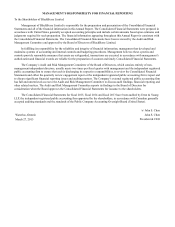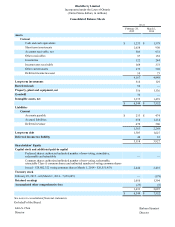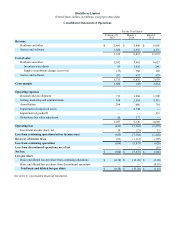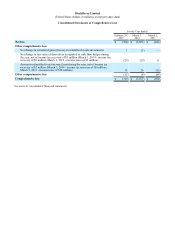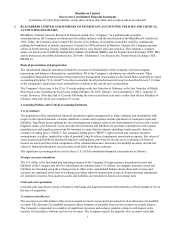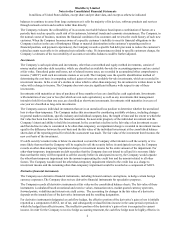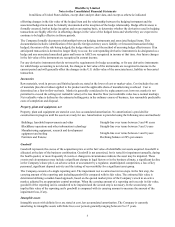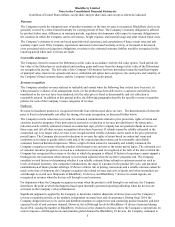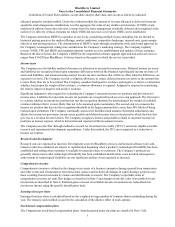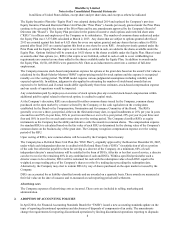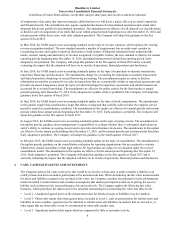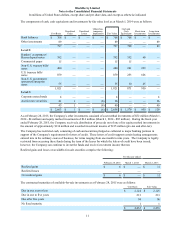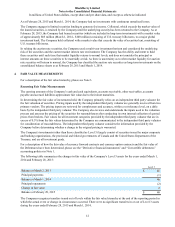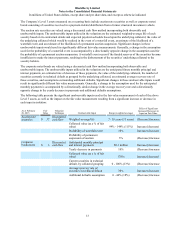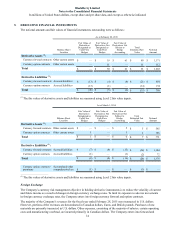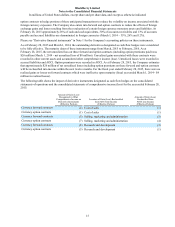Blackberry 2015 Annual Report Download - page 80
Download and view the complete annual report
Please find page 80 of the 2015 Blackberry annual report below. You can navigate through the pages in the report by either clicking on the pages listed below, or by using the keyword search tool below to find specific information within the annual report.
BlackBerry Limited
Notes to the Consolidated Financial Statements
In millions of United States dollars, except share and per share data, and except as otherwise indicated
5
Warranty
The Company records the estimated costs of product warranties at the time revenue is recognized. BlackBerry devices are
generally covered by a time-limited warranty for varying periods of time. The Company’s warranty obligation is affected
by product failure rates, differences in warranty periods, regulatory developments with respect to warranty obligations in
the countries in which the Company carries on business, freight expense, and material usage and other related repair costs.
The Company’s estimates of costs are based upon historical experience and expectations of future return rates and unit
warranty repair costs. If the Company experiences increased or decreased warranty activity, or increased or decreased
costs associated with servicing those obligations, revisions to the estimated warranty liability would be recognized in the
reporting period when such revisions are made.
Convertible debentures
The Company elected to measure the Debentures at fair value in accordance with the fair value option. Each period, the
fair value of the Debentures is recalculated and resulting gains and losses from the change in fair value of the Debentures
are recognized in income. The fair value of the Company’s Debentures has been determined using the significant inputs
of principal value, interest rate spreads and curves, embedded call option dates and prices, the stock price and volatility of
the Company’s listed common shares, and the Company’s implicit credit spread.
Revenue recognition
The Company considers revenue realized or realizable and earned when the following four criteria have been met: (i)
when persuasive evidence of an arrangement exists, (ii) the product has been delivered to a customer and title has been
transferred or the services have been rendered, (iii) the sales price is fixed or determinable, and (iv) collection is
reasonably assured. In addition to this general policy, the following paragraphs describe the specific revenue recognition
policies for each of the Company’s major categories of revenue.
Hardware
Revenue for hardware products is recognized when the four criteria noted above are met. The determination of when the
price is fixed or determinable can affect the timing of revenue recognition, as discussed further below.
The Company records reductions to revenue for estimated commitments related to price protection, rights of return and
customer incentive programs. Price protection is accrued as a reduction to revenue provided that (i) the future price
reduction can be reliably estimated or based on contractual caps, (ii) the Company has not granted refunds in excess of
those caps, and (iii) all other revenue recognition criteria have been met. If refunds cannot be reliably estimated or the
contractual cap is no longer valid, revenue is not recognized until reliable estimates can be made or the price protection
period lapses. The Company also records reductions to revenue for rights of return based on contractual terms and
conditions as it relates to quality defects only and, if the expected product returns can be reasonably and reliably
estimated, based on historical experience. Where a right of return cannot be reasonably and reliably estimated, the
Company recognizes revenue when the product sells through to an end user or the return period lapses. The estimated cost
of customer incentive programs is accrued as a reduction to revenue and is recognized at the later of the date at which the
Company has recognized the revenue or the date at which the program is offered. If historical experience cannot support a
breakage rate, the maximum rebate amount is accrued and adjusted when the incentive programs end. The Company
considers several factors in determining whether it can reliably estimate future refunds or customer incentives such as
levels of channel inventory, new competitor introductions, the stage of a product in the product life cycle, and potential
cannibalization of future product offerings. If there is a future risk of pricing concessions and a reliable estimate cannot be
made at the time of shipment, the Company recognizes the related revenue and costs of goods sold when its products are
sold through to an end user. Shipments of BlackBerry 10 devices, and BlackBerry 7 devices in certain regions, are
recognized as revenue when the devices sell through to end customers.
For shipments where the Company recognizes revenue when the product is sold through to an end user, the Company
determines the point at which that happens based upon internally generated reporting indicating when the devices are
activated on the Company’s relay infrastructure.
Significant judgment is applied by the Company to determine whether shipments of devices have met the Company’s
revenue recognition criteria, as the analysis is dependent on many facts and circumstances. During fiscal 2014, the
Company shipped devices to its carrier and distributor partners to support new and continuing product launches and meet
expected levels of end customer demand. However, the sell-through levels for BlackBerry 10 devices decreased during
fiscal 2014, causing the number of BlackBerry 10 devices in the channel to increase above the Company's expectations. In
order to improve sell-through levels and stimulate global demand for BlackBerry 10 devices, the Company continued to


